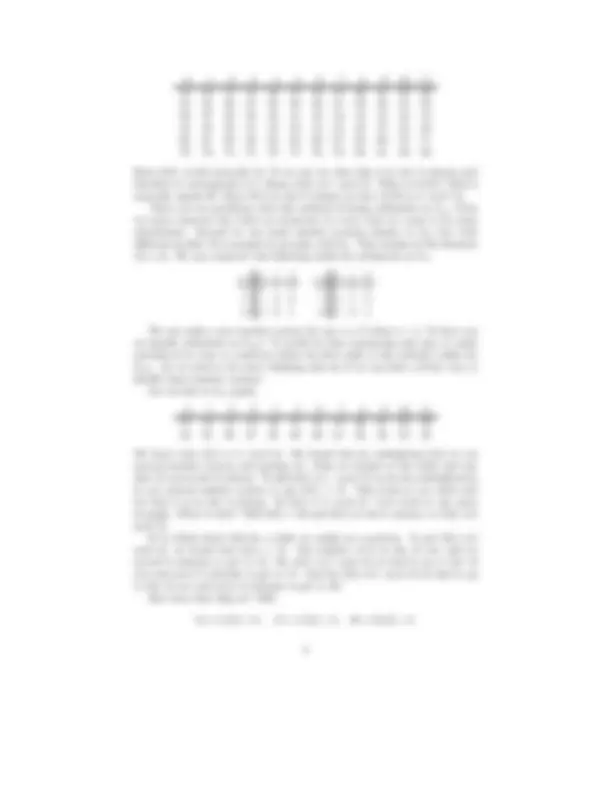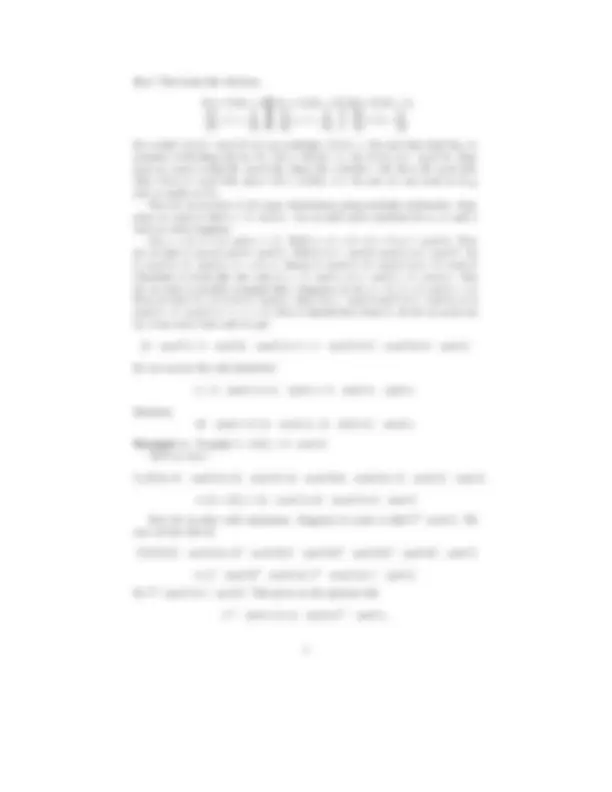





Study with the several resources on Docsity

Earn points by helping other students or get them with a premium plan


Prepare for your exams
Study with the several resources on Docsity

Earn points to download
Earn points by helping other students or get them with a premium plan
Community
Ask the community for help and clear up your study doubts
Discover the best universities in your country according to Docsity users
Free resources
Download our free guides on studying techniques, anxiety management strategies, and thesis advice from Docsity tutors
The concept of congruences and modular arithmetic using the example of the number system z12. It covers addition and multiplication in z12, and provides rules for finding remainders of larger numbers modulo a given number. The document also includes examples and exercises.
Typology: Assignments
1 / 7

This page cannot be seen from the preview
Don't miss anything!




First let us recall some facts about division. Suppose that we were to divide 6 by 2. Then the quotient is 3 and the remainder is 0. So we have
6 2 = 3 iff 6 = 2(3)
Now suppose we were to divide 7 by 2. The quotient is 3 and the remainder is
If we multiply both sides by 2 we get
7 = 2(3) + 1.
And so in general if we divide b by a and get a quotient of q and remainder of r we can write this as b = aq + r. Suppose that it is 11:00. What time will it be in 2 hours? Well in 1 hour it will be 12:00 and in 1 more hour it will be 1:00. We will call this clock arithmetic.
Figure 1: A 12 hour clock.
We would like a number system that behaves like clock arithmetic. But we need our new number system to have a 0. Recall that in military time we start with 0 and go to 23. So we will do the same thing and start with 0, but we will only go to 11 in our number system.
Figure 2: The number system Z 12
We will call this new number system Z 12 , which is pronounced “z mod 12”. We can do arithmetic in our new number system if we are a little careful. So for example 2 + 3 = 5 7 + 2 = 9 5 + 6 = 11 1(7) = 7 2(3) = 6 2(5) = 10
This makes sense because if we start at the number 2 and advance 3 steps around Figure we will be at 5. What if we tried to add 11 + 2? In our normal number system that would be 13, but there is no number 13 in Z 12. So what do we do? Well if we start at 11 and advance 2 steps around Figure we will be at 1. So we could say that 11 + 2 = 1, but this might be a little confusing since 11 + 2 = 13 in our normal number system. So what we will do is to write this as
11 + 2 ≡ 1 mod 12.
So we can now add or multiply any two numbers from Z 12.
5 + 7 ≡ 0 mod 12 8 + 9 ≡ 5 mod 12 2 + 3 + 9 ≡ 2 mod 12 3(4) ≡ 0 mod 12 3(5) ≡ 3 mod 12 8(9) ≡ 0 mod 12
The addition is pretty easy. Start with the first number in the addition and advance around Figure however far the second number tells you to go. Now since multiplication can be thought as a shorthand for addition we could do it the same way. For example 3(5) = 5 + 5 + 5. So we could start at 5 and advance by 5 and then advance by 5 again. This could become cumbersome for 8(9). One way of calculating this product would be to construct the following table.
Hey! This looks like division:
12 = 1(12) + 0 15 = 1(12) + 3 30 = 2(12) + 6 12 12
So to find 11(11) mod 12 we can multiply 11(11) = 121 and then find the re- mainder of dividing 121 by 12: 121 = 10(12) + 1. So 11(11) ≡ 1 mod 12. Sup- pose we want to find 30 mod 105. Since 30 = 0(105) + 30, 30 ≡ 30 mod 105. Also 110 ≡ 5 mod 105, since 110 = 1(105) + 5. So now we can work in Z 105 just as easily as Z 3. Now let us see how to do some calculations using modular arithmetic. Sup- pose we want to find a + b mod n. Let us pick some numbers for a, b, and n and see what happens. Let a = 3, b = 6, and n = 2. Well a + b = 3 + 6 = 9 ≡ 1 mod 2. Now let us find 3 mod 2 and 6 mod 2. Well 3 ≡ 1 mod 2 and 6 ≡ 0 mod 2. So 3 mod 2 + 6 mod 2 = 1 + 0 = 1. Hence 3 mod 2 + 6 mod 2 ≡ 3 + 9 mod 2. Therefore it looks like the rule is a + b mod n ≡ a mod n + b mod n. But let us look at another example first. Suppose we let a = 3, b = 5, and n = 2. Now we have 3 + 5 ≡ 8 ≡ 0 mod 2. Also 3 ≡ 1 mod 2 and 5 ≡ 1 mod 2, so 3 mod 2 + 5 mod 2 = 1 + 1 = 2. But it should have been 0. So let us mod out by 2 one more time and we get
(3 mod 2 + 5 mod 2) mod 2 ≡ 1 + 1 mod 2 ≡ 2 mod 2 ≡ 0 mod 2.
So we can see the rule should be
a + b mod n ≡ (a mod n + b mod n) mod n.
Similarly ab mod n ≡ ((a mod n) · (b mod n)) mod n.
Example 1. Simplify 5 + 2(4) + 11 mod 3. Well we have
5+2(4)+11 mod 3 ≡ (5 mod 3+(2 mod 3)(4 mod 3)+11 mod 3) mod 3
≡ (2 + 2(1) + 2) mod 3 ≡ 6 mod 3 ≡ 0 mod 3
Now let us play with exponents. Suppose we want to find 7^4 mod 3. We can rewrite this as
7(7)(7)(7) mod 3 ≡ ((7 mod 3)(7 mod 3)(7 mod 3)(7 mod 3)) mod 3
≡ (7 mod 3)^4 mod 3 ≡ 14 mod 3 ≡ 1 mod 3.
So 7^4 mod 3 ≡ 1 mod 3. This gives us the general rule
am^ mod n ≡ (a mod n)m^ mod n.
What is 8^4 mod 3?
84 mod 3 ≡ (8 mod 3)^4 mod 3 ≡ 24 mod 3 ≡ 8 mod 3 ≡ 2 mod 3.
Next let us look at 5^12 mod 7. Since 5 ≡ 5 mod 7 we cannot simplify this like before. So we need a new trick. First we recall that bm+n^ = bmbn^ and (bn)m^ = bmn. The other part of the trick is to rewrite 12 in the right way. We will write 12 as 8 + 4. So 512 = 58+4^ = 5^854.
Now
54 mod 7 ≡ (5^2 )^2 mod 7 ≡ 252 mod 7 ≡ 42 mod 7 ≡ 16 mod 7 ≡ 2 mod 7
and
58 mod 7 ≡ (5^4 )^2 mod 7 ≡ 22 mod 7 ≡ 4 mod 7.
So
512 mod 7 ≡ 5854 mod 7 ≡ 2(4) mod 7 ≡ 8 mod 7 ≡ 1 mod 7.
So why did I write 12 as 8 + 4? Before I explain why i did this let me explain how I choose 8 and 4. First recall your powers of 2:
n 0 1 2 3 4 5 6 7 8 9 10 2 n^1 2 4 8 16 32 64 128 256 512
Now to rewrite 12 I first look for the largest power of 2 less than 12. This is 8. So 12 = 8 + 4. Since 4 is a power of 2 I am done.
Example 2. Write 13 as a sum of powers of 2. First we find the largest power of 2 smaller than 13. This is 8 , So 13 = 8 +5. Now find the largest power of 2 smaller than 5 , it is 4. So 13 = 8 + 4 + 1. Since 1 is a power of 2 we are done.
Example 3. Let us see some more expansions as sums of powers of 2.
7: 7 = 4 + 2 + 1
23 23 = 16 + 4 + 2 + 1
50: 50 = 32 + 16 + 2
Divide b by a and write the result in the form b = aq + r, where q is the